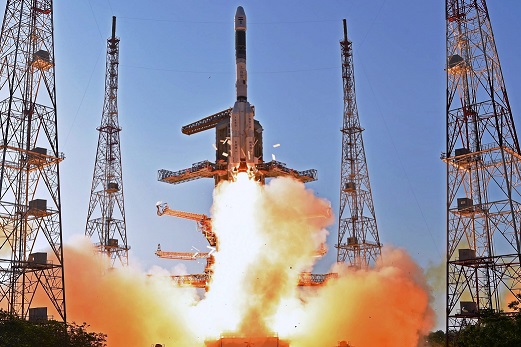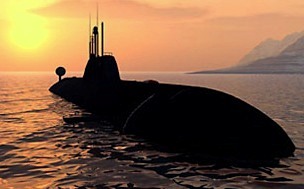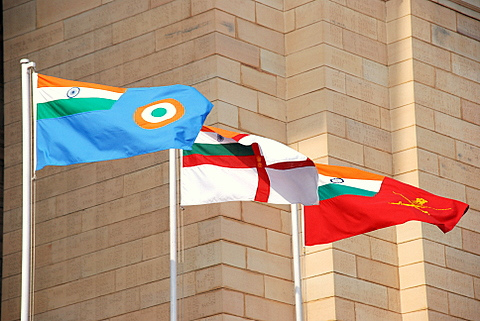
ISRO's communication satellite GSAT-9 on-board the GSLV-F09 rocket lifts off from Satish Dhawan Space Center in Sriharikota on Friday. A PTI photo
BENGALURU (PTI): In a first, India on Friday successfully launched a South Asia Satellite to provide communications and disaster support to neighbouring countries, a space initiative described as a "giant and historic step" in boosting regional cooperation.
Giving a fillip to India's new age space diplomacy and "neighbourhood first" policy, the Rs 235 crore satellite GSAT-9 built as part of a Rs 450 crore project and touted as an 'invaluable gift' to India's neighbours is seen as a significant move in countering Chinese interests in the region. The project is funded entirely by India.
The cuboid-shaped 2,230 kg satellite named SAS will enable a full range of services to the neighbours, including in telecommunication, television, direct-to-home, VSATs, tele-education and telemedicine. The South Asian Satellite (SAS) mission life is 12 years.
Seven of the eight SAARC countries – India, Sri Lanka, Bhutan, Afghanistan, Bangladesh, Nepal and Maldives – are part of the ambitious project. Pakistan has opted out of the project, saying it has its own space programme.
Soaring majestically in clear weather, the GSLV-F09 rocket blasted off at 1657 IST on Friday from the second launch pad at Satish Dhawan Space Centre at Sriharikota in Andhra Pradesh, about 350 km from Bengaluru, and injected the satellite into orbit 17 minutes later in a flawless flight.
"The launch of South Asian Satellite tells us that even the sky is not the limit when it comes to regional cooperation," Prime Minister Narendra Modi told the leaders of the six nations celebrating the success of the launch during a video conference.
Modi earlier took to Twitter to announce the successful launch of the south Asian satellite, which is his brainchild, calling it a "historic moment."
"It opens up new horizons of engagement. This will also greatly benefit South Asia & our region's progress," he tweeted.
Nepal Prime Minister Pushpa Kamal Dahal, Bangladesh Prime Minister Sheikh Hasina, Bhutan Prime Minister Tshering Tobgay, Sri Lanka President Maithripala Sirisena, Maldives President Abdulla Yameen and Afghan President Ashraf Ghani also addressed through videoconferencing.
Lauding Modi's vision, the leaders hailed the mission as a giant step in strengthening regional cooperation.
The launch took place away from the media glare, with journalists kept at bay and a reticent ISRO keeping details of the mission and the programme under wraps.
In Sriharikota, ISRO Chairman A S Kiran Kumar said, "We have just transported South Asia Satellite from Earth to geostationary transfer orbit using our geosynchronous launch vehicle mark II that makes use of indigenously developed cryogenic engine."
He said the satellite operations and control will be carried out from ISRO's Master Control Facility at Hassan, Karnataka and that in the coming few weeks the satellite will reach its destination-geostationary orbit.
GSLV-F09 mission is the 11th flight of GSLV, called a "naughty boy" as it has a patchy record with half of its mission ending in failures in the past.
Built by the Indian Space Research Organisation, the SAS rode piggyback on the 50m-tall rocket Geosynchronous Satellite Launch Vehicle GSLV-F09 with the indigenous Cryogenic powering the Upper Stage. GSLV-F09 mission is the 11th flight of GSLV.
GSAT-9 is a Geostationary Communication Satellite providing various communication applications in Ku-band with coverage over South Asian countries.
It can also provide secure hotlines among the participating nations, which will be useful for management of disasters like earthquake, cyclone, floods and tsunami.
Ghani described the launch as "South Asia's giant step towards regional cooperation" and said it makes the region's integration a reality.
"Today marks the day where South Asia moves from speaking about desirability of regional integration to making it a reality. The gap between talk and action is bridged today."
After coming to power in May 2014, Prime Minister Modi had asked ISRO scientists to develop a SAARC satellite that can be dedicated to neighbouring countries as a "gift from India."
On his 'Mann ki baat' programme on Sunday last, Modi had announced that the South Asia Satellite would be India's "priceless gift" to its neighbouring countries.
"On May 5, India will launch the South Asia Satellite.
The benefits of this satellite will go a long way in meeting the developmental needs of the countries participating in this project," Modi had said.
Extending his "Sabka saath, sabka vikaas" concept, SAS is part of Modi's 'Neighbourhood First' policy focusing on India's South Asian neighbours.
The previous launch of communication satellite GSAT-8 was on May 21, 2011 from Kourou, French Guiana.
South Asia is considered prone to tropical cyclones, heat waves, earthquakes, tsunamis, landslides and floods.
The launch is considered significant as it is part of Space diplomacy to extend India's footprint over the region.
It comes close on the heels of a record breaking launch of 104 mini satellites by ISRO with a single rocket in February.
 Previous Article
Previous Article Next Article
Next Article












The Indian Air Force, in its flight trials evaluation report submitted before the Defence Ministry l..
view articleAn insight into the Medium Multi-Role Combat Aircraft competition...
view articleSky enthusiasts can now spot the International Space Station (ISS) commanded by Indian-American astr..
view article